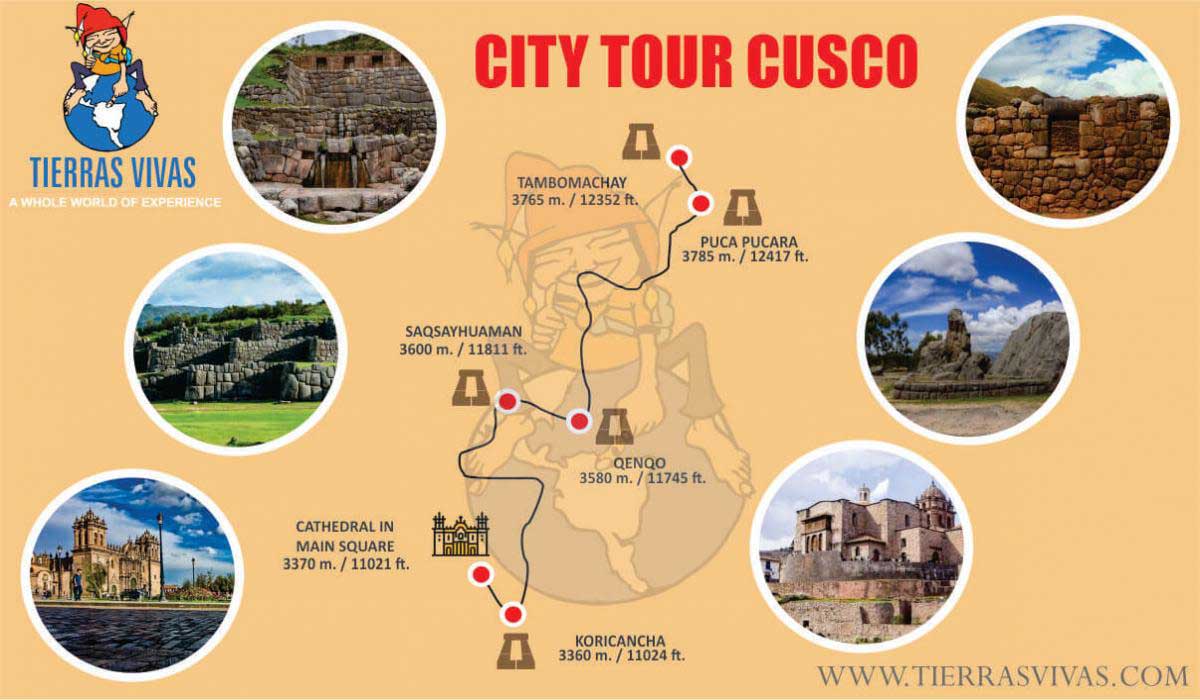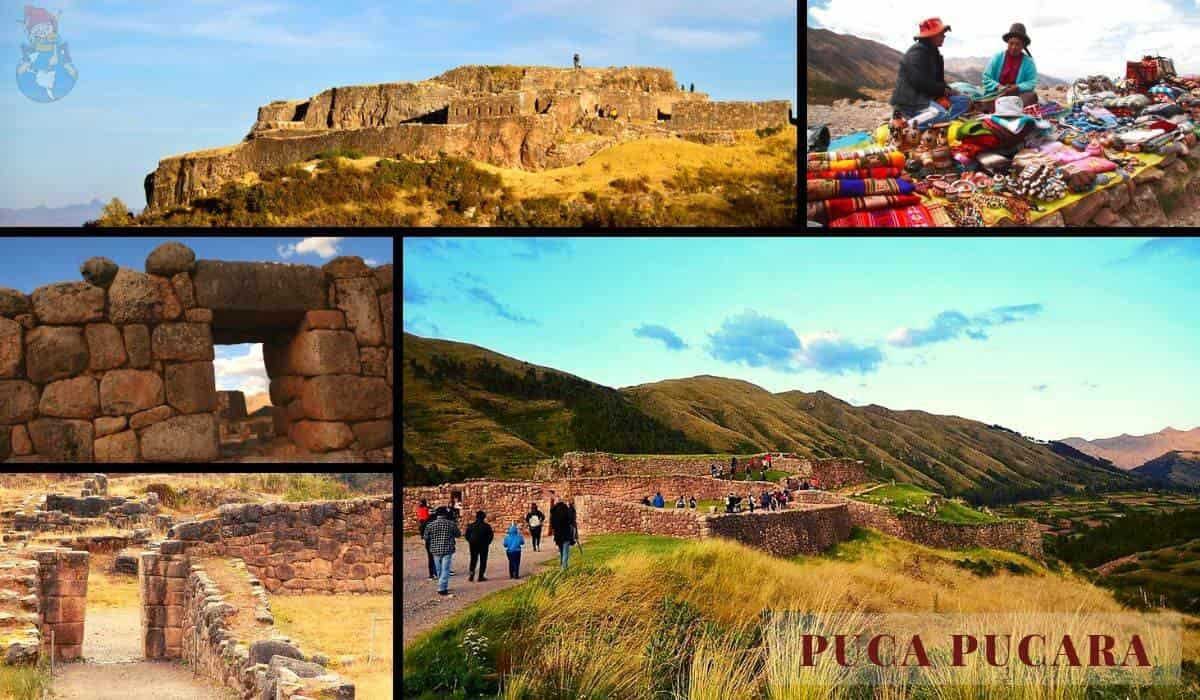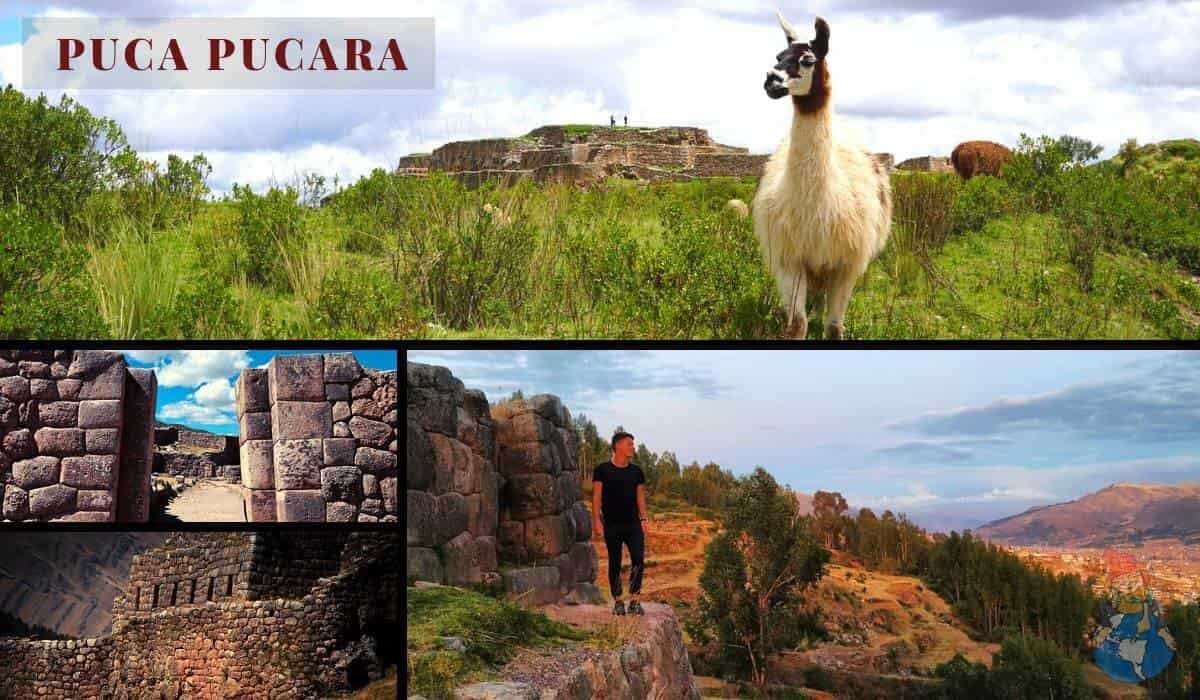Puca Pucara or Pukapukara is undoubtedly one of the main archaeological sites near the city of Cusco along with Sacsayhuaman, Qenqo and Tambomachay.
Due to being on an elevated platform like Sacsayhuaman, it was called a fortress. However, its function is still a mystery. Currently it is a place that can not be missed in the Imperial City before knowing Machu Picchu.
With your visit to Puca Pucara that will not take you more than 20 minutes you will be able to acquire good knowledge about Inca culture, history and architecture.
Puca Pucara is a somewhat secluded place, but it is also worth visiting, especially if family trips are being made as well as in the company of friends.
General Information about Puca Pucara
- Location: Puca Pucara is located to the northeast of the archaeological site of Saqsaywaman, 8 km from the city of Cusco, two kilometers from the town of Yuncaypata, 900 meters from the archaeological site of Tambomachay and 4 kilometers from the archaeological site of Qenq'o, (components of the Archaeological Park of Sacsayhuaman). Following the road towards Pisaq at the UTM coordinates N179250 E8507474.
- Climate: The climate is dry and temperate. The average temperature per year is 12 ° C. There are 2 stations during the year. The rainy season (from November to March) presents a greater amount of fluvial rainfall. The dry season (April to October) has hottest days in the day and cold at night.
- Altitude: 3785 meters above sea level - 12417 ft.
- Price: The ticket is included in the tourist ticket - BTC
- Visiting Hours: Hours from Monday to Sunday: from 7:00 a.m. to 6:00 p.m.
How to get to Puca Pucara?
To get to Puca Pucara Peru Tierras Vivas offers you 3 options for all travelers who will visit the city of Cusco.
Bus to Puca Pucara
The bus to Puka Pukara is very functional due to the short distance between Cuzco and Tambomachay, so the minibuses, for a cost of approximately 6 soles, will reach this incredible destination.
- Being very close to the city of Cusco there is a line of public service buses called 'Sr del Huerto' with a route that goes to Tambomachay and Puca Pucara with an approximate price of 2 soles.
Puca Pucara - Cusco Walk
You can also take a walking tour that will take you about 2 hours. We recommend you follow the road that leads from Cusco to Pisac, reaching Tambomachay and Puca Pucara. Then take transportation to the city of Cusco.
Puca Pucara Tour
After flying from the capital of Perú, Lima, you will arrive in Cusco. The Puca Pucara Tour is included in the Tour of the city of Cusco, which can be contracted with any travel agency in Cusco.
These excursions, mostly, consist of a guided tour taking your Cusco BTC Tourist Ticket as well as other destinations such as Tambomachay, Sacsayhuaman, Qenqo, etc.
When is the Best time to visit Puca Pucara?
The best season to visit Andahuaylillas is during the dry season, which covers the months April to the end of September. In October the rains begin and you can find Machu Picchu covered by clouds. If you travel in June, we recommend you to book the Inti Raymi 2020 Tour that takes place in June 24th, and also hike the Palcoyo Mountain Tour, which is an incredible Rainbow Mountain located in the Andes.
Other Archaeological Sites you can visit near Cusco:
Very close to the city, south of Cusco, there are other archaeological centers from pre-Inca, Inca times and a beautiful colonial church known as 'The Sistine Chapel of America'. You can also explore these wonders in less than a day through the tourist circuit of the South Valley Cusco and learn a little more about the history of Cusco and enjoy wonderful landscapes. Here the list of archeological centers located in the south of Cusco:
- Piquillacta Archaeological Site
- Raqchi Archaeological Site
- Tipón Archaeological Site

Other Tours you can book in Cusco:
The famous Inca Trail Tours are the most popular excursions in Cusco - Peru; and considered among the best walks in the world.
- Salkantay Trek 5 Days
- Inca Quarry Trail 4 Days
- Machu Picchu 3 Day Hike
- 2 Day Inca Trail Tour
- 2 Day Inca Trail with camping
Puca Pucara Meaning
According to the ethno historical data of the sixteenth and seventeenth centuries, the archaeological site would not have a name that corresponds to the function it could have originally fulfilled, since the twentieth century they use the name Puka Pukara to catalog it. This very catchy name comes from the original language of Cusco (Quechua).
Puca that refers to the red color and Pucara that means Fortress or Sheltered Place, denominating 'Red Fortress' to this incredible Inca construction of reddish stones of medium size, nevertheless; the site has no trace of having been a fortress.
Puca Pucara History
Taking as a reference historical data and archaeological evidences provided by the fragments of ceramics found in the archaeological excavations of the Ministry of Culture, Puca Pucara can be given chronological data between 1350 and 1480, D.C.
The word 'Puca Pucara' is not found in any of the chronicles that are our main source of information, likewise there is no evidence that Puca Pucara was a military building. Its denomination is mainly due to its appearance of Inca fortress and its elevated location. Likewise, there are no data on armed confrontations but we can observe enclosures destined for the settlement of soldiers.
Recent theories indicate that Puca Pucara was a place of rest or 'Tambo' for the entourage that accompanied the Inca in his visit to Tambomachay as well as offering food and shelter to the Inca messengers (Chasquis). These, through the road network 'Qhapan Ñac' linked the main urban and religious centers throughout the empire.
Nowadays, you can follow the Qhapaq Ñan path trough amazing treks like the Inca Trail Trek to Machu Picchu, the incredible 6 days trek from Vilcabamba to Machu Picchu, walking on inca trails preserved and exploring the unexplored where there is a story for every Inca monument that you see along the trip; and the Short version of the Classic Inca Trail to Machu Picchu.
- Particularly one of the roads crossed Puca Pucara. After 600 years the path is partially destroyed, but it is still easy to distinguish the union of Puca Pucara with Huchuy Qosqo and Calca in the Sacred Valley of the Incas.
Architecture of Puca Pucara
Based on studies conducted since the early twentieth century, by different specialists, mainly archaeologists, it is stated that Inca architecture has been characterized by a series of attributes marked by three principles: symmetry, solidity and simplicity. From this morphological point of view there is a regularity that allows to differentiate it, qualitatively, from other developments that occurred in the Andean space.
Tambomachay, Puca Pucara and surrounding areas present constructions of religious and civil character, belonging to the ruling class, within an architectural style of the Imperial Inca, for its limestone walls, as well as for evidences of andesite lithic elements. As for the shapes and spatial arrangement, they are conditioned to the topography of the place.
It presents rectangular constructions that give a free space to a quad are distributed by levels, constituting an efficiently coherent set, solving the levels through accesses, bleachers or ramps and by the conformation of terraces.
Each site presents a typical model of territorial distribution, appropriate to its architectural style and its geographical configuration, which becomes an evident reality of the function it originally had. Defining it from material elements found in different campaigns of archaeological excavations.
The archaeological site of Puca Pucara belonging to the archaeological park of Sacsayhuaman - Cusco Region gathers a whole set of architectural particularities, which it is necessary to identify in association with the archaeological site of Tambomachay, belonging to the same area.
There is a series of rocks carved with architecture that do not seem to belong to a civil or military style and that can correspond to a ritual function, knowing by primary source that these sites were Huacas 'religious places'.
These rocks of unequal sizes that form the different buildings, is very similar to the style of the Pisac Ruins. If you want to see and enjoy a much more worked Inca architecture, with a more meticulous and millimeter completion, in the surroundings of Cusco we recommend you do it in these other archaeological sites and places:
Puca Pucara, besides being a huaca, according to the references of the chronicle of Father Bernabé Cobo (1653), probably had different functions in context with the other archaeological sites in the area, fulfilling an important role in ancient times.
Unlike the enormous stones that build Sacsayhuaman, Puca Pucara is represented by structures corresponding to enclosures and walls of regular size, in relation to the natural formation of limestone, and which continue at the same level, according to the wall of this site.
For a better knowledge of the archaeological site we take, as an initial point of reference, the current entrance to the monument, represented, in a close-up, by two sources that have the following characteristics:
The first wall
With a stroke avoiding to cut the rocks that stand out we found 6 rooms of different sizes of irregular shape not touching the rocks of the wall.
To the west we find the square of trapezoidal shape which is accessed from an exterior staircase. Formerly the square was surrounded by buildings being 9 the ones without any fortification.
The second wall
Surrounding the central elevation are two walls, with wide platforms to the east and south of the site. On the back of this wall it is possible to find 3 rooms with typical Inca architecture.
The third wall
It is surrounding the top without any trace of the buildings that could exist in this place. The buildings consist of stones of sizes between medium and small, the surface of the rocks is very rugged in comparison with other archaeological remains of the Inca civilization.
According to some chroniclers of the time, they explain: When the Inca was visiting Tambomachay to pay homage to the Water, his delegation composed of soldiers and dancers remained in Puca Pucara, which functioned as a barracks and a resting place 'Tambo'. Giving supposition to rumors about a chincana (tunnel), which serves as a link between these two Inca constructions.

Function of Puca Pucara Cusco
Puca Pucara was a center with different functions in context with the other archaeological sites, fulfilling the ceremonial or religious, administrative and control function because of its geographical location and visible architectural features.
Based on archaeological aspects as well as ethnological we give numerous possibilities of the functionality of the archaeological site of Puca Pucara.
Possible Function Based on Archaeological Evidence:
The archaeological site of Puca Pucara, according to material evidences represented by its architecture, ceramics and other samples that have been recovered through archaeological excavations, poses a series of questions and their consequent answers.
The location of Puca Pucara as a strategic point of forced passage, in association with a large pre-Hispanic road, allows to hypothesize that it was a site of control and administration, related to the taxation of those who had to pass through the sector.
Considering Tambomachay as Puca Pucara places associated with the water cult, considering them important centers of administrative, tributary and religious organization.
On the other hand, it is evident that Tambomachay and Puca Pucara, considered as independent units and as ‘huacas’ specifically destined for certain ceremonies or offerings closely related to water, because in both places there are ceremonial sources and, although with different supplies (one of a type outcrop Manante and another from the distant lagoon of Locrecocha), both sites are related to the same main river that rises from the gulch of strength.
Relating the two archaeological sites both have the same style of architecture, with the same characteristics in the material use of limestone, with some combinations of andesite stone, present in their accesses, bridges, windows and niches.
This allows us to state that they correspond to a specific cultural development and to a certain imperial Inca period. These proposals are supported by the archaeological works carried out by the Ministry of Culture, which in different campaigns carried out archaeological excavations and restorations of both sites, as well as their value.
The reports of these works have also allowed us to verify, for the recovered remains, underground structures, mainly ceramics, that correspond to the imperial Inca period. Although in Tambomachay not much pottery was found, in Puca Pucara fragments of Inca ceramics were found, like remains of the colonial and republican era, expressed in the samples of glazed ceramics and of a large quantity of osseous remains of cattle and sheep, even with contemporary ceramic mix.
Finally, the archaeological site of Puca Pucara is very special in relation to its orientation, because from this point you can see the main sacred hills or 'Apus' that for the Incas constituted a constellation of gods, mentioned in the chronicles of the XVI and XVII centuries and identified today with the names of 'Pachatusan', 'Ausangate' and 'Huanacauri'.
Possible Function Based on Ethnological Data
During archaeological studies, in the sector corresponding to the curve and facing the snowy Ausangate, two circular holes were found, covered with coal and ash, and at a short distance remains of candy.
According to the surveys carried out in the nearby communities (Tambomachay, Yanahuaylla, Yuncaypata and Huayllarcocha) it was a 'payment to the land'; that is an offering to Mother Earth or 'Pachamama', made by peasants of the area, with different metallic objects, wool, food, drink, flowers, etc.
The settlers of the place affirm that each element placed in the 'payment' fulfills a purpose or objective using the lands of all the Archaeological Complex of Sacsayhuaman to bury them, when being sacred places.
These answers show that to this day there are cultural habits practiced by the people of Cusco, allowing us to give a vision to the possible uses of these constructions.
It is evident then, from the ethnological data, that Puca Pucara has an important role within the religious conception of the current comuneros that live in the Archaeological Park of Sacsayhuaman, in spite of Western acculturation, so it can be said that there is a Survival of the site as 'huaca' or sacred place.
For Lovers of the Flora and Fauna of Cusco and the World:
In Puca Pucara we clearly notice a fauna and flora of inter-Andean forests and very abundant puna vegetation in the Cusco area.
Flora of Puca Pucara:
We have to observe in our visit to Puca Pucara an abundant presence of the 'Ichu' pastures of the area, ferns and many trees named by the locals as: the queuña, the waqo, the achupalla de monte, the raqui-raqui, the moqo- moqo
Fauna of Puca Pucara:
With a bit of luck and a non-hurried visit to the complex you will be able to observe amazing local fauna such as the Andean Fox, Vizcachas and lizards.
For bird lovers Puca Pucara welcomes Swallows, Partridges, Gilgeros and Cernicalos flying over the site throughout their visit.
In Cusco there are different conservation areas where it is possible to find flora and fauna in the wild. Here is the list of conservation areas that you can visit in Cusco and around:
- Qosqoccahuarina Private Conservation Area
- Choquequirao Regional Conservation Area
- Tres Cañones Regional Conservation Area
- Historic sanctuary of Machu Picchu. Is important to book your Machu Picchu Tickets in advence to enjoy your Vacation in Machu Picchu withour any problem.
- Otishi National Park
- Asháninka communal reserve
- Megantoni National Sanctuary
- Machiguenga communal reserve







